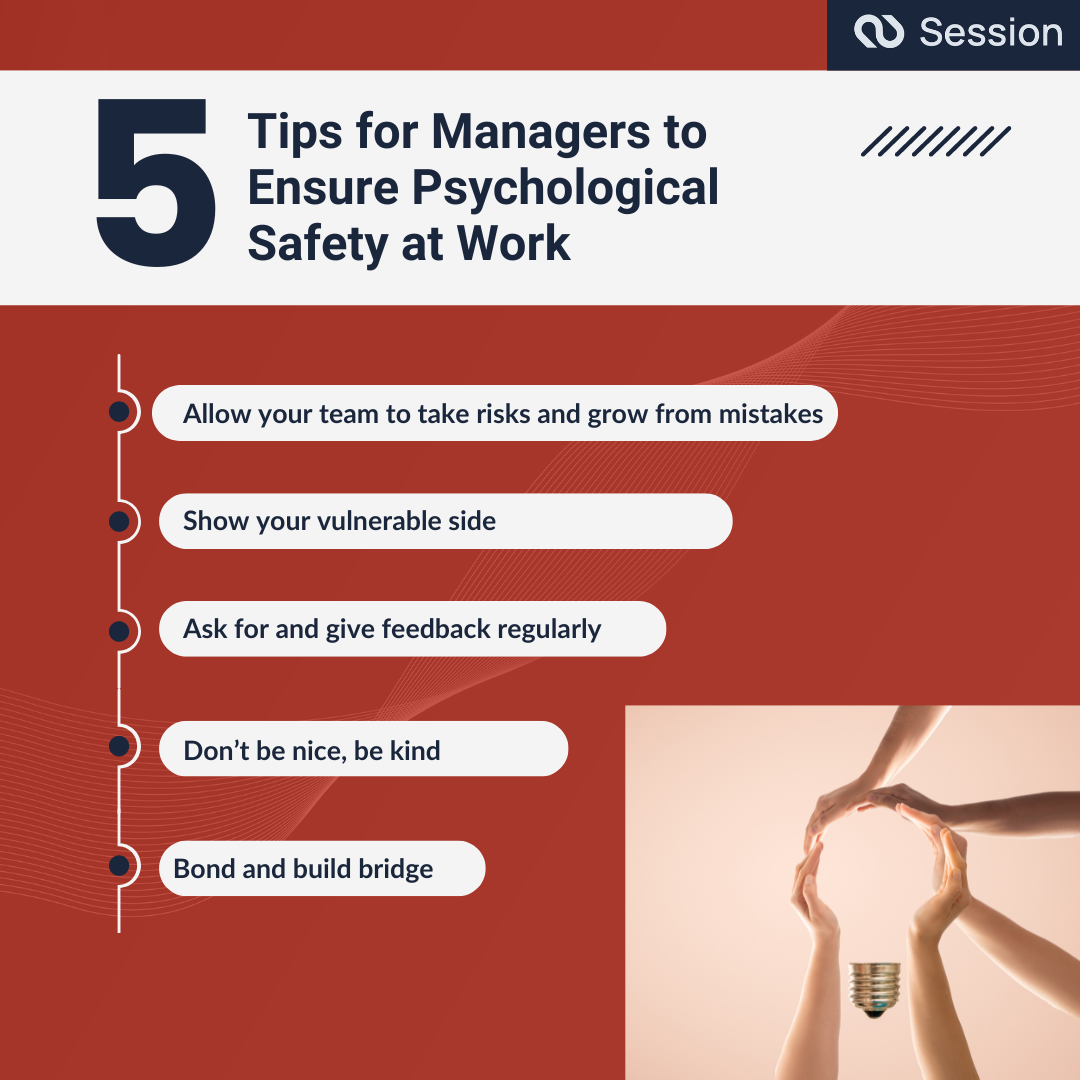All humans want to feel connected, valued, liked by their peers, and feel like their contributions matter. Yet, many employees feel the opposite of this; dealing with fear, anxiety, and low self-esteem - particularly in high-stress work environments. The antidote to disengagement and low confidence within the workplace is psychological safety. More and more people are starting to discover the meaning of psychological safety, and are starting to demand it. Psychological safety is more crucial today than ever before, as increased uncertainty and volatility in the world has left employees feeling anxious and more uncertain of their futures. In this article, I'll run through the importance of psychological safety in the workplace, and explore some best practices on how to create and maintain it.

What Constitutes a Psychologically Safe Workplace?
Psychological safety can be described as an environment where vulnerability is rewarded and where there is a belief that one will not be punished or humiliated for speaking up with ideas, questions, concerns or mistakes. In other words: in a psychological safe environment, the cost of being your authentic self is low. Amy Edmondson and Timothy Clark have enriched the perspective on psychological safety lately with their respective work on the topic.
The term refers to individuals feeling safe speaking up, asking for help, admitting mistakes, or challenging the status quo, all without reprimand. According to Amy Edmondson, author of The Fearless Organization: Creating Psychological Safety in the Workplace for Learning, Innovation, and Growth, people must be allowed to voice half-finished thoughts, ask questions out of left field, and brainstorm out loud in order to create a culture that truly innovates. A psychologically safe workplace is one where employees dare to speak up and make mistakes without the fear of humiliation and punishment. In psychologically safe teams, the team members give each other feedback and challenge each other. Thus, candor and authenticity are central elements. Also, healthy and constructive conflicts are a main part of forming a psychologically safe team.
In reality a psychological safe team tolerates and deals with conflict and friction as a natural part of being a team. As stated by the late Mary Parker Follett, friction is a good and constructive thing and just as the mechanical engineer capitalizes on it so should teams. What teams must be aware of is the nature of the conflict and friction they are dealing with. Here it is wise to distinguish between intellectual friction and social friction, as the former is the constructive force that allows for generating ideas and innovation and the latter is the destructive force, generating fear and conflict, as outlined in Timothy Clark’s book The 4 Stages of Psychological Safety: Defining the Path to Inclusion and Innovation (Berrett-Koehler 2020).
Psychological Safety Makes for Better Teams and Cultures
If leaders only talk about accountability and a culture of performance excellence, they risk employees slipping into the ‘’anxiety zone’’ - in which they are too afraid to voice their opinions or raise their concerns. When employees don’t feel psychologically safe they will tend to hold back and spend capacity and time on managing impressions rather than creating impact in their designated role. When employees are in the anxiety zone, their overall mental capacity and ability to perform decreases. One of the keys of psychological safety is that people feel comfortable voicing their opinions and do not fear being judged. To ensure that teams and individuals are able to voice their inputs and opinions in a safe environment, create some guidelines on how they interact with one another. Guideline examples include:
- Active listening without interruption
- Facilitate that everyone in the team is heard through equal distribution of talk time
- Accepting varied ideas as valid, accepted, and never judged
- Not placing blame on a person for voicing their opinion
- Encouraging and listening to out of the box suggestions, and recognizing that everyone is different
Individuals who feel part of a community and a deep sense of belonging are happier humans. Not only do employees who feel psychologically safe generally thrive, they also create more value as they have better conditions to unleash their talent and their abilities.
Why is Creating Psychological Safety Difficult?
Even though psychological safety in theory might sound simple and easy to implement, it has proven to be quite difficult. Interestingly, an explanation for this difficulty can be found in evolutionary psychology. When humans lived in tribes and survived as hunter-gatherers, being rejected or ostracized from the community was equal to death, as survival was impossible without the tribe. This fear of rejection has remained hardwired in our DNA, as research also shows that rejection triggers the same brain pathways that are activated when we experience physical pain (Eisenberger, 2009).
So, how does our innate fear of rejection and need to be part of the tribe relate to psychological safety? Simply put, behaviors that can potentially expose us in front of others, i.e., asking a question, providing input, seeking feedback, or making a suggestion, can make us susceptible to the risk of appearing ignorant, incompetent, intrusive, or negative in front of others.
This may lead to feelings of rejection, which our brains interpret as a threat, and therefore actively avoid. The human tendency to avoid situations that may trigger perceived rejection means that organizations need to work harder at encouraging psychological safety. This is why organizations need a blueprint for creating psychological safety - and execute it with rigor. In the next section, we’ll explore some steps and frameworks to do so:
How Can Managers and Leaders Ensure Psychological Safety?
Psychological safety doesn’t happen overnight, nor does it happen without continuous, measured effort. All members of a team and/or in an organization play a role and have a responsibility to co-foster psychological safety, but leaders in particular play a vital role as the leader acts as a role model and a cultural designer. Follow the steps below to make an impact:
- Allow your team to take risks and grow from mistakes: One of the biggest psychological threats is the fear of committing mistakes. Employees are often risk-averse in the workplace for fear of appearing incompetent, ignorant, or exposing their fallibility. However, everyone is fallible, and it’s human nature to make mistakes. A healthy psychological safety culture allows team members to be creative and take risks without fear of repercussions. To ensure that your team feels safe to experiment and take risks, you must create an environment where everyone knows that making mistakes is okay. Whenever a mistake is repeated over and over again, we should no longer celebrate the mistake, rather we need to explore why it is repeated and we need to act, e.g., by assigning another colleague to the given task.
- Show your vulnerable side: Managers who shy away from being vulnerable contribute to an environment where employees feel ashamed to show any vulnerability. When managers and leaders admit their shortcomings or struggles, they are opening up the floor for candid discussions to take place. Leaning into your imperfections and fallibility creates a culture that says ‘’it’s okay not to be perfect, it’s okay to make mistakes.’’
- Ask for and give feedback regularly: Managers and leaders are typically the people who give feedback, but it’s also important to be able to receive feedback. Inviting others to give you feedback and leaning into the space where you are on the receiver's side can potentially lead to a positive spiral where others are encouraged to ask you to give them feedback. When you give feedback, be specific, constructive and solutions-oriented, but remember: No matter how constructive you believe you are, feedback can trigger defense mechanisms, making people less receptive to new ideas. Separate feedback from evaluation where you can, clearly make your feedback focused on development and problem-solving and evaluate on performance separately.
- Don’t be nice, be kind: Sometimes, situations arise that require a manager or leader to take corrective action if an employee is continuously underperforming. In these cases, honesty is kindness. Not approaching an employee for fear of upsetting them is often more detrimental than being honest, as you will be hindering their growth and improvement. Instead, try opening up the conversation on how they can improve, and provide actionable feedback and steps to getting there.
- Bond and build bridge: Building relations is an important part of building trust and fostering psychological safety as building relations increases empathy, which we know increases our relatedness to each other. We bond with people that in many ways are similar to ourselves, whereas with people who we share less similarities we need to build bridges and invest more effort. Often bonding is an easier discipline than building bridges, but if we want to foster psychological safety we need to be aware of connecting with both those who are similar to us (bonding) and those who are different (building bridges).
Summing it all up
Organizations need psychological safety for innovation, purpose, and profit. Individuals need psychological safety to thrive, feel a sense of belonging, and do the best in their careers. Cultivating a psychologically safe work environment is not just good for the bottom line - it’s the right thing to do, at a human level, for all of us. Therefore, creating psychological safety is not a matter of choice. It’s a matter of obligation. And I simply believe that you can’t afford not to invest in creating a psychologically safe workplace.













